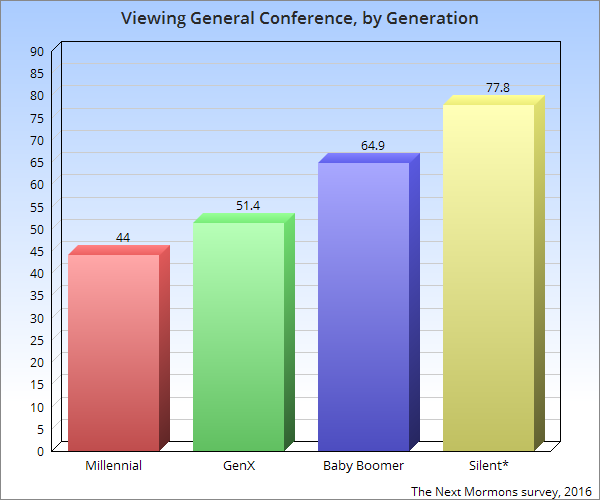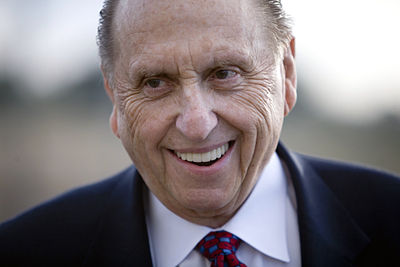
The website of the April 2017 LDS General Conference. The second, third, and fourth sessions convene today.
This weekend, Mormons around the world will join together in viewing five of the six sessions of the LDS Church’s semiannual General Conference (the first session happened last weekend).
Or at least, some Mormons will.
There has been a notable generational shift in the viewing of General Conference. According to the 2016 Next Mormons survey, most 52+ adults who self-identify as LDS watched at least one part of LDS General Conference in the last six months, with the oldest (the Silent Generation) registering more than three-quarters participation.*
Just over half (51.4 percent) of GenXers had seen any of Conference, and only 44 percent of Millennials had.
In other words, there is more than a thirty-point drop between the oldest generation of Mormons and the youngest in how many had viewed General Conference in the last six months.

(I want to make it clear that because today is Conference, this is not my annual April Fool’s post. If you’d like to read previous AF posts for a laugh, see here and here and here.)
Overall, it’s surprising that many otherwise orthodox Mormons seem to be skipping Conference as a viewing activity, particularly when so many options now exist for streaming sessions online after Conference is over.
There are lots of possible reasons for this; here are just four. The first two are relevant to all Mormons, and the last two are particularly relevant to younger adults.
1. It’s not must-see-TV.
Perhaps the Church’s curricular focus on General Conference talks in other contexts has driven viewing rates down; there may be less impetus to watch Conference if the next week’s sacrament meeting talks will focus on it or it will be dissected over the next year in Relief Society and priesthood meetings.
I would add here that it’s also rare for anything truly exciting to happen at Conference (with the most famous recent exception being the 2012 announcement of lowering the missionary age).
2) We’re watching (or not) at home.
In the United States at least, the last twenty years have seen a deep shift in the location of Conference viewing. Many people now watch it at home, either online or via satellite TV, versus the old model of getting dressed up and going to the church to watch it with other church members.
While this domestication has introduced many wonderful new traditions for Mormon families watching together at home, it has also eliminated what social scientists would consider an opportunity for the social facilitation of “performance gains.” The basic notion here is that we put forward our best selves when other people can see us. When other people can’t see us, we don’t push ourselves for the same level of performance.
This is important because there’s no longer a social cost attached to not watching Conference; in fact, other members of the community probably won’t even know if we don’t watch. In that private context we’re less likely to push ourselves to sacrifice as much time and effort.
3. There’s a growing generation gap.
Millennials may be “tuning out” because they don’t see themselves represented. When members of the Silent Generation watch General Conference, they are guaranteed to see and hear men from their own generation, since just over half of the members of the First Presidency and Quorum of the Twelve are Silents—and two, President Monson and President Nelson, are remnants of the Greatest Generation before them. (By comparison, just 11 percent of Mormons in America are in the Silent Generation, and one percent are of the Greatest Generation, according to 2014 Pew data.)
Baby Boomers, too, can find kindred spirits of their own age in a third of the Quorum and a majority of the Seventies and auxiliary leaders who also speak.
This is not the case for GenXers and Millennials, who will be hard pressed to find any leaders of their generations. The cultural touchstones that general authorities refer to are often events that occurred before those younger generations were even born.
Lest we think that the LDS Church has always been this way, we should recall that it was founded by a young man in his early twenties and has, throughout its history, often featured a cross-generational leadership with many decades separating the apostles who served at any one time. President Monson, for example, was only thirty-six years old when he was called to serve in the Twelve; the late Boyd K. Packer was forty-five. They served in partnership with older and more experienced men. Today’s leadership model, by contrast, caters exclusively to the superannuated.
4. Young adults are less engaged with institutions.
Younger Mormons’ non-participation in General Conference may also reflect a more pervasive apprehension about religious institutions—one that pertains in the nation as a whole, not just to any one religion. Generational researchers have noted that both GenXers and Millennials seem averse to large institutions—the stereotype being that GenXers are suspicious of them, and Millennials are not suspicious so much as disengaged or apathetic.
There’s some truth to those stereotypes. Pew has tracked Millennials’ disaffection from various institutions, including religious ones, and noted steep declines in even a few short years.
In 2010, for example, 73 percent of Millennials said they believed churches and religious organizations had a positive effect on where the country was going, but when the question was asked again just five years later, only 55 percent still felt that way. As younger people aged into the survey—and as existing Millennials became more discouraged by the world around them—the overall effect was an eighteen-point drop in confidence in religious institutions.
Our survey was less alarming. In general, it showed Mormon Millennials to be far more positive about religious institutions than their non-Mormon Millennial peers . . . but not nearly as enthusiastic as their Mormon elders.
I’ll be posting more about these findings in the months to come, but for our purposes this weekend it’s worth asking why more than half of Mormon Millennials—the same people we know from other questions in the study are strong believers in LDS teachings—are going to be giving this weekend’s Conference a miss.
* The Next Mormons survey is a nationally representative sample of 1155 current and 541 former Mormons; only the currently-identified Mormons are included in this post’s data. Generally, the Silent Generation’s responses are collated with the Baby Boomers’ because the Silents’ numbers were small. Still, I’ve included the Silents by themselves in the chart above just because it helps to visually illustrate the overall trend we’re seeing: that viewing GC is declining from one generation to the next.






